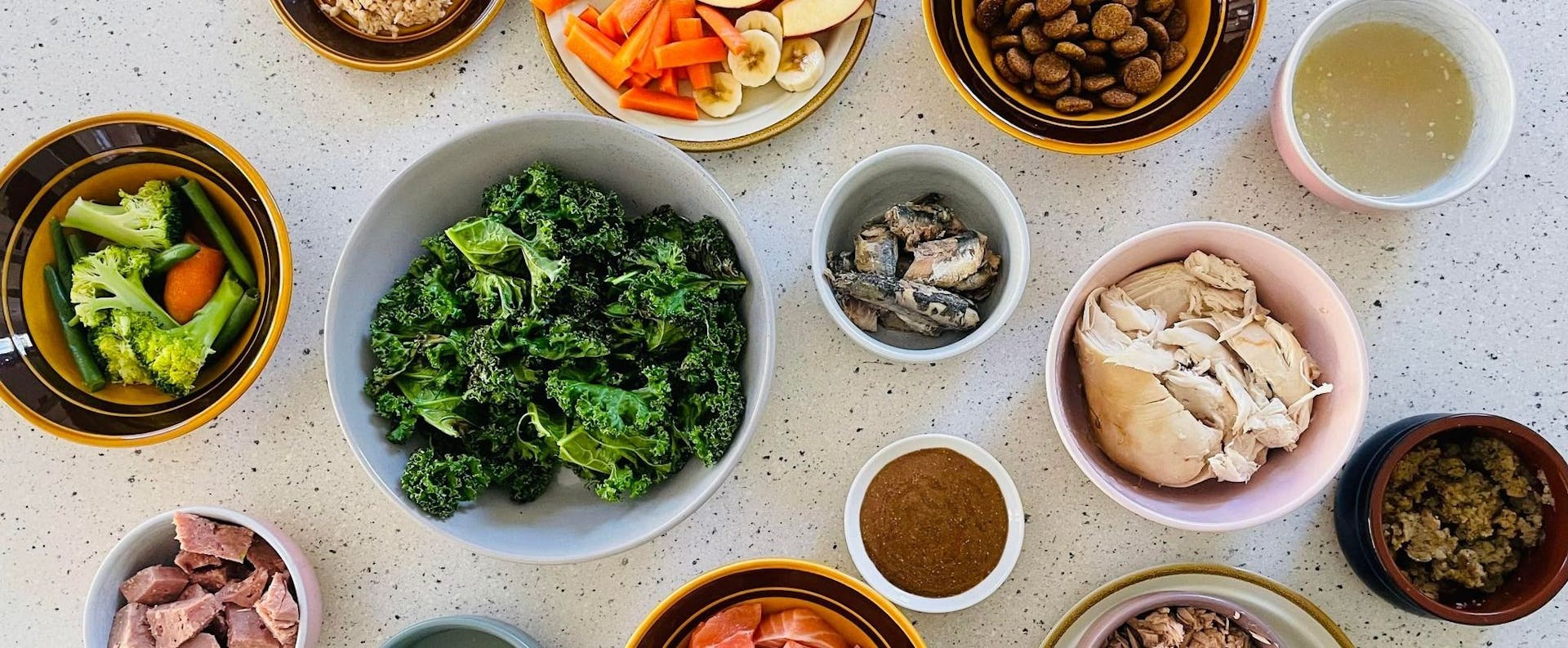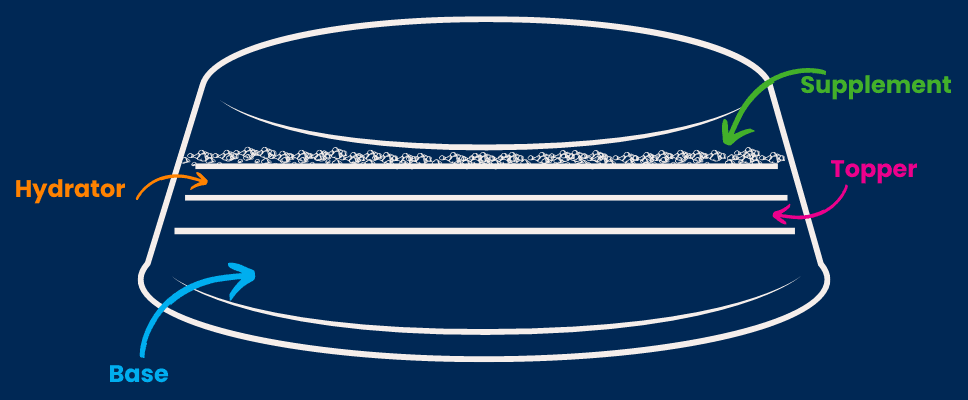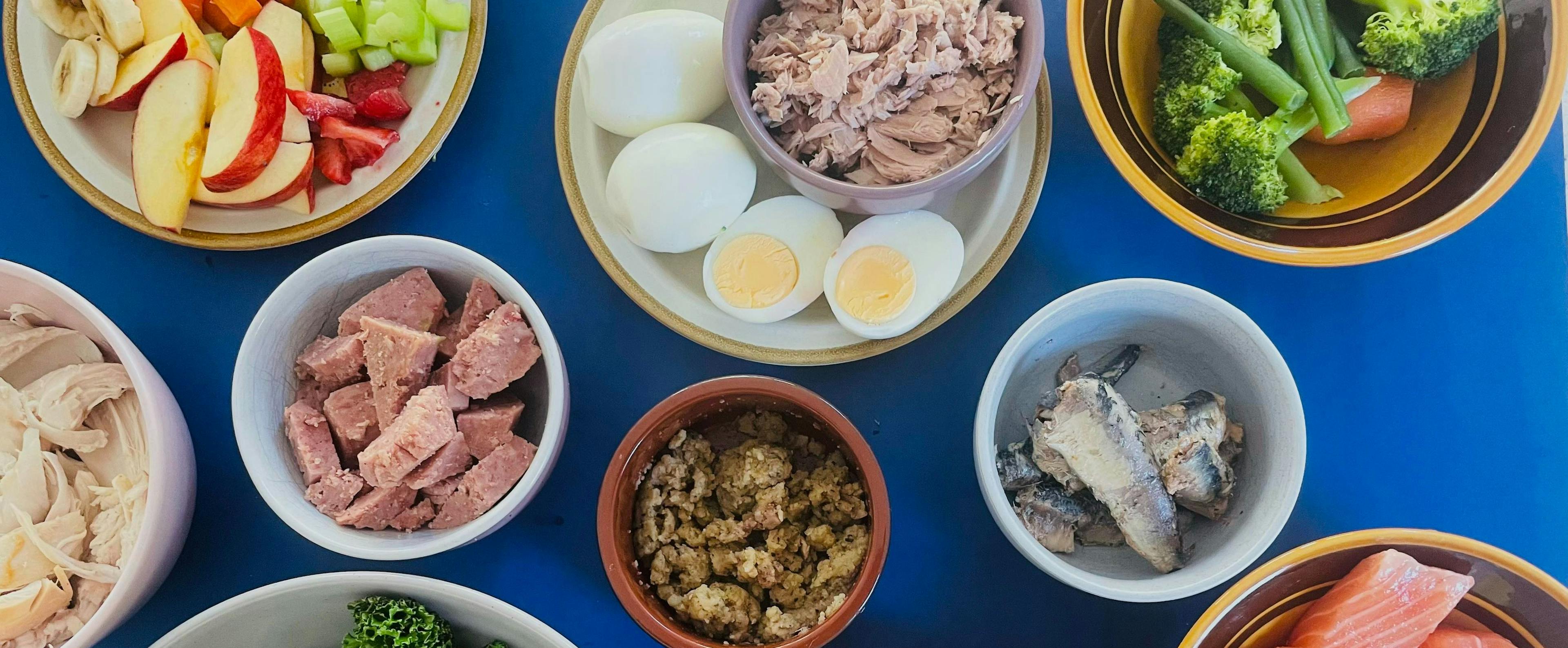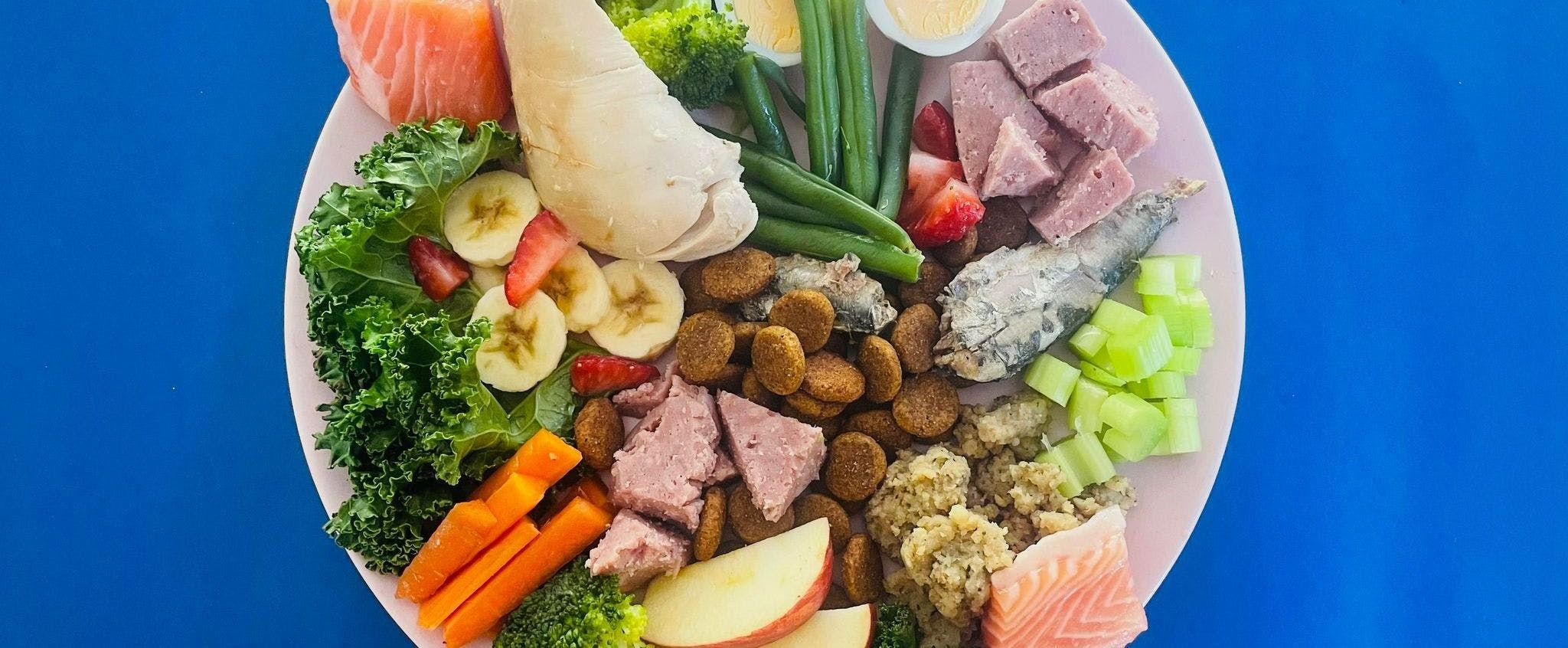
It’s important to ensure your dog’s diet is balanced – and that they’re getting all the nutrition they need to live a long and healthy life. There are multiple ways to do this – but the ‘build your bowl’ feeding system is perhaps the easiest way to provide your dog with variety while ensuring they’re getting everything they need. Practicing this style of feeding results in health benefits for your pets and improves their longevity. And it can be done in four simple steps!
What Is The ‘Build Your Bowl’ Trend For Dogs?
Build Your Bowl is a feeding system for dogs which involves incorporating different styles of food into your dog’s diet to ensure they’re getting maximum nutritional benefit from their meals. It also provides balance and variety – helping your dogs live longer, healthier lives. It can be completely customised for your dog’s individual needs – far better serving them than a singular off-the-shelf product.
Most dog owners give their pet either dry food, a version of wet food or a mix of both. The Build Your Bowl feeding system isn’t dissimilar to this, it just involves a few extra steps to complete the meal. Your bowl will comprise of a base, a topper and a hydrator and will be finished off with supplements.
Follow these steps to build your dog’s bowl!

How To Build Your Dog’s Bowl
Step 1: Pick Your Base
The base of your bowl will form your dog’s main source of nutrition. It can come from a single source, or it can be a mix of few different types of food based on your dog’s needs.
Examples of bases include dry food, wet food, fresh or frozen rolls and freeze-dried food. Note that the latter options are more expensive – so it’s more affordable to choose a dry kibble base and then use the latter options as a topper to balance it out.
Step 2: Add a Topper
Once you’ve got your base, you’ll need to add your topper. This should be a nutrient-dense food source (avoid food with fillers – your topper should be majority protein) that contrasts your base.
Examples of toppers include tinned food and pouches, freeze-dried food, raw mince, fresh and frozen rolls as well as commercially available fish, meat and/or veggies. Ensure your topper is not the same as your base.
Hot tip: When choosing your base and topper, make sure you pick two different textual elements – so if you choose wet food for your base, don’t use a pouch as your topper. Mix it up and create variety.
Step 3: Add a Hydrator
A lot of pets don’t drink enough water throughout the day – so it’s a good idea to add it into their meals to ensure they’re staying hydrated, particularly for dogs with kibble in their diet. Adding a hydrator also adds more nutrients and flavours to their meal – it’s a great way to convince picky dogs to eat!
Examples of hydrators include pet-friendly broths, stocks, milk, and gravy. Make sure you're using products specifically formulated for pets - as dogs cannot have traditional milks and store-bought stocks and gravies are often too high in sodium.
Step 4: Finish it off with Supplements
For maximum benefits, mix additional vitamins and supplements into your dog’s daily diet. You can customise these based off your dog’s individual needs – you may choose supplements for coat care, joint support, calming chews, digestive aids, overall health boosters...the list goes on. Health supplements will have dosage instructions on the packaging – make sure you read these and follow them to ensure your dog is receiving the correct dose.
You can also stir fruit or vegetables through your dog’s meal at the end as a natural supplement! Find a full list of dog-friendly fruit and vegetables below.

Factors That Affect Your Dog’s Diet
To get the maximum benefits from building your dog’s bowl, you’ll need to determine their individual needs. Here are six factors to consider:
Breed
Different breeds = different needs. Breed is a good indicator of overall requirements and a strong place to start when considering your dog’s nutrition. Some breeds (like German Shepherds, Golden Retrievers and Dachshunds) are predisposed to joint issues, for example, and they would benefit from hip and joint supplements or joint support formulated dry food. Size is also something to take into account: small breeds tend to prefer smaller kibble or toppers while larger breeds are prone to wolf their food down and incorporating raw food in their bowls is a strategy to slow them down.
Age
Ever noticed your metabolism slow down? It happens to pets too. Energetic puppies need 2-3 times more food than adults – and calorie-dense kibble is useful to have on hand to ensure they’re getting their daily requirements. Senior dogs, on the other hand, need smaller portions and extra moisture from a good hydrator. Senior dogs also benefit from senior support supplements, while puppies will be better off with healthy growth supplements.
Fitness
Is your dog getting a bit chonky? Switch up calorie-dense kibble for leaner raw meats or single-protein loafs. Highly active dogs need moisture to keep hydrated and protein for energy – which can be achieved by feeding them wet toppers and hydrator. Underweight dogs might need a high-calorie food supplement.
Location
If you live somewhere hot, your dog needs to work hard to keep hydrated and dogs often don’t drink enough water. Balance this out by using milk-based hydrators. If you live somewhere cold or wet and your dog isn’t able to get out as much, reduce the size of their calorie-heavy base and supplement that with broth.
Medical Condition
There are a broad range of supplements available for any number of medical conditions – from dental health to sensitive stomachs and urinary conditions, you can support your dog’s health starting with their diet. You can also assist your dog with natural ingredients – dogs that need more fibre in their diet would benefit from adding vegetables like green beans, pumpkin, and kale.
Season
Bad winter weather translates to less times outdoors and fewer calories burnt, so consider reducing portions and swapping out calorie-heavy food for lighter options like broths and lean meats. Summer leaves pets extra thirsty and hungry so a hydrator may help keep things on track.
Ultimately the ‘build your bowl’ trend is all about customisation – consider the needs of your dog and head in-store if you need help with different elements.
Raw Food Options For Dogs
It’s a good idea to incorporate some fresh and natural food into your dog’s bowl – and you can change this up regularly to ensure your dog is getting the nutritional benefits from a wide range of foods.

What Vegetables Can My Dog Eat?
Broccoli: Nutrient-packed Broccoli contains Vitamins A, C and D, beta-carotene, folic acid, fibre, calcium, and chromium.
Brussel Sprouts: Brussel Sprouts contain vitamin A, B1, B6, K and G and are a good source of fibre.
Carrots: Carrots are a great natural chew, as they assist with cleaning teeth and gums. They contain vitamins A, C, D, E and K, beta-carotene, iron, magnesium, potassium, and fibre.
Celery: Believe it or not, celery can freshen your dog’s breath! It also contains vitamins A, B and C, and is good for heart health.
Cucumbers: Cucumbers are low in calories, carbohydrates, fats, and oils - making them an excellent natural additive for overweight dogs. They contain vitamins C, B1 and K, as well as potassium, copper, magnesium, and biotin so they're full of good stuff.
Green beans: Beans are full of fibre while being low in calories.
Peas: Cooked, frozen or thawed (but not canned) peas can be fed to dogs. Peas are a natural source of protein, and they contain vitamins A, B1, B2, B3, B6, C and K in addition to thiamine, phosphorus, manganese, fibre and folate.
Kale: Kale is high in iron and contains key vitamins like K and A, which assist with bone health, immune function, fetal development and energy metabolism.
Spinach: Spinach contains potassium, magnesium, and vitamins B6, B9 and E. It also contains high amounts of carotenoids, vitamin C, vitamin K, folic acid, iron and calcium.
Beets: Beets provide vitamin C, fibre, folate, manganese, and potassium. These nutrients help your dog's digestion and immune system and supports a healthy skin and coat.
Sweet Potato: Sweet potatoes are great for digestive health because they're high in fibre. They contain vitamin B6, vitamin C, and manganese, and they are rich in the antioxidant beta-carotene.
Pumpkin: Contains lots of vitamins and minerals like A, C and B6 which help your dog's immune system, vision, and cardiovascular function.
Certain vegetables are toxic to dogs – onions, garlic, chives, and rhubarb are all no-nos for example. Never assume an individual vegetable is safe to feed your dog – always check first to make sure it's safe before feeding them something for the first time.
What Fruits Can My Dog Eat?
Apples: Apples are a great source of Vitamin A & C as well as fibre - and they're low in fat which is an added bonus. Be careful not to feed your dog the whole apple – apple seeds are toxic so be sure to remove the core and seeds.
Bananas: Contain natural sugars that can give your dog a boost in energy. They also contain amino acids, potassium, vitamin C and B6 and improve heart health and blood pressure.
Blueberries: Blueberries contain antioxidants which prevent cell damage in people and pets. They are also low in calories.
Cantaloupe: Cantaloupe is an excellent source of Vitamin A and C, as well as potassium and fibre. Be mindful of it's high calorie content though and choose other additives if your dog is overweight. Do not feed your dog the seeds.
Cranberries: Fed in small quantities (they're tart and relatively high in sugar) cranberries can add a healthy dose of fibre and antioxidants.
Orange: Oranges contain vitamin C, potassium, and fibre.
Peaches: Avoid canned peaches because of their sugar, but once the pit and skin have been removed from a peach, they are a great source of fibre and vitamin A.
Pears: Once the pit and seeds have been removed, pears are rich in copper, fibre and vitamins C and K.
Pineapple: Pineapple is a great sweet treat for dogs containing vitamins, minerals, fibre and bromelain.
Strawberries: Believe it or not, strawberries contain and enzyme that helps to brighten your dog’s teeth! They are also full of fibre and vitamin C. Feed these to your dog in moderation because they are relatively high in calories and sugar.
Watermelon: Watermelon contains Vitamin A, B-6 and C as well as potassium. It's also full of water, making it a great hydrating option!
Certain fruits are toxic to dogs – grapes and avocados are to be avoided at all times and seeds like those that are found in apple cores or the pips in stone fruits can contain cyanide which is poisonous. Never assume an individual fruit is safe to feed your dog – always check first.
We hope you have fun with the build your bowl trend! Give the trend a go and tag us on @petstockaustralia so we can see your creations.